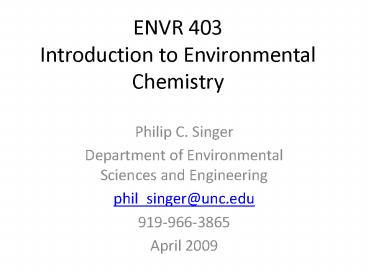ENVR 403 Introduction to Environmental Chemistry - PowerPoint PPT Presentation
1 / 48
Title:
ENVR 403 Introduction to Environmental Chemistry
Description:
ENVR 403 Introduction to Environmental Chemistry Philip C. Singer Department of Environmental Sciences and Engineering phil_singer_at_unc.edu 919-966-3865 – PowerPoint PPT presentation
Number of Views:178
Avg rating:3.0/5.0
Title: ENVR 403 Introduction to Environmental Chemistry
1
ENVR 403Introduction to Environmental Chemistry
- Philip C. Singer
- Department of Environmental Sciences and
Engineering - phil_singer_at_unc.edu
- 919-966-3865
- April 2009
2
Topics
- 1. Chemistry of Natural Waters
- 2. Purification of Water
3
1. Chemistry of Natural Waters
- Redox Equilibria
- -speciation
- -dissolved oxygen resources
- Acid-Base Equilibria
- -speciation
- -the carbonate system and alkalinity
- Solubility Equilibria
- -metal solubility
- -aqueous lead (Pb) solubility
4
pH and pE as Master Variables
H2CO3 HCO3- H Ka1 pH pKa1 Log
HCO3-/H2CO3
NO3- 10H 8e- NH4 3H2O Kred pE -1/8
(pKred) 1/8 (Log NO3- H10/NH4) pEo
-1/n (Log Kred) pE pEo 1/n Log
Ox/Red) Analogy to Nernst Equation EH EoH
2.3 RT/nF (Log Ox/Red)
5
After M. Benjamin, 2002
6
After M. Benjamin, 2002
7
(No Transcript)
8
(No Transcript)
9
After M. Benjamin, 2002
10
After M. Benjamin, 2002
11
Dissolved Oxygen Depletion(Oxygen Demand)
- Carbonaceous oxygen demand (CBOD)
- CH2O O2 CO2 H2O
- C6H5OH 7O2 6CO2 3H2O
- Nitrogenous oxygen demand (NOD)
- NH4 2O2 NO3- H2O 2H
- Chemical oxygen demand (COD)
- 3CH2O 2Cr2O72- 16H 3CO2 4Cr3
11H2O
12
Dissolved oxygen sag curve
dC/dt -kLCBOD - kN NOD kH
(Cs-C) where C dissolved oxygen
concentration CBOD carbonaceous oxygen
demand NOD nitrogenous oxygen demand Cs
dissolved oxygen saturation concentration
13
Nutrient Enrichment of Surface Waters and
Eutrophication
- Photosynthesis
- CO2 NO3- PO43- H2O ? Algae biomass O2
- (C106H263O110N16P)
- Respiration
- Algal biomass O2 ? CO2 NO3- PO43- H2O
14
(No Transcript)
15
(No Transcript)
16
(No Transcript)
17
(No Transcript)
18
(No Transcript)
19
(No Transcript)
20
(No Transcript)
21
(No Transcript)
22
Electroneutrality Equation (Charge Balance) for
Natural waters
- Major Cations Na, K, Ca2, Mg2
- Major Anions Cl-, SO42- , NO3-, HCO3-, CO32-
- Charge Balance
- Na K 2Ca2 2Mg2 H Cl-
2SO42- NO3- HCO3- 2CO32- OH- - Cb-Ca Acid neutralizing Capacity Alkalinity
- HCO3- 2CO32- OH- H
23
What is the pH of pure rainwater? Pure
rainwater contains only dissolved CO2 in
equilibrium with the atmosphere. H2CO3 KH
PCO2 10-5M What is the pH of a 10-5M solution
of H2CO3? Cb-Ca Alkalinity 0 H HCO3-
2CO32- OH- K1HC/D 2 K1K2C/D where
D H 2 K1 H K1K2 Answer pH 5.65
24
If a body of water has a pH of 7.5 and an
alkalinity of 2x10-3 equivalents/L, what is the
equilibrium pH of the water if 10-3 eq./L of acid
is added to the water? Use initial pH and given
alkalinity to find total carbonate concentration
C C (Alkalinity H - OH-) /((K1H/D)
2K1K2/D) 2.12x10-3 M Added acid consumes
alkalinity New alkalinity 2x10-3 10-3 10-3
eq/L Find new pH from alkalinity
expression Alkalinity HCO3- 2CO32-
OH- H 10-3 ((K1H/D) 2K1K2/D) 2.12
x10-3 OH- H Find pH 6.35
25
After M. Benjamin, 2002
26
(No Transcript)
27
(No Transcript)
28
ENVR 419 Chemical Equilibria of Natural
Waters Fall 2009 1100-1215 Tu/Th
29
2. Purification of Water
- Drinking Water
- Wastewater
- Contaminated Groundwater
30
Sources of Drinking Water
- Fresh Water
- Ground Water
- Surface Water
- -Rivers and streams
- -Lakes and impoundments
- Brackish Water
- Reclaimed Wastewater?
- Importance of Watershed Protection
31
Potential Contaminants in Drinking Water
- Pathogenic microorganisms
- Bacteria (salmonella, cholera), viruses
(Hepatitis A virus, poliovirus), protozoan cysts
(Giardia, Cryptosporidium) - Suspended particles (turbidity)
- Dissolved inorganic contaminants
- e.g. Fe, Mn, As, Cr, Cu, Pb, NO3-, ClO4-
- Dissolved organic contaminants
- e.g. taste and odor-causing organics, pesticides,
pharmaceutically active compounds
32
Objectives of Drinking Water Treatment
- Removal of particulate material
- Removal of color (natural organic material, humic
substances arising from vegetative decay) - Removal of taste and odor-causing substances
- Removal of harmful contaminants - chemical and
microbial - Residual protection of water during distribution
- protect against microbial recontamination,
corrosion
33
(No Transcript)
34
Chemicals Used in Water Treatment
- Coagulants
- Aluminum, ferric salts
- Polymers
- Disinfectants
- Chlorine, chlorine dioxide, ozone
- (UV-Irradiation)
- Acids/Bases for pH adjustment
- Lime, caustic
- Sulfuric Acid
- Corrosion Control
- Phosphates, silicates
- Other
- Fluoride
35
Membrane Filtration
- Thin barrier or film of material that allows
certain substances to pass through while
rejecting other substances.
Feed Water
Filtered Water (Permeate)
36
Membrane Removal Functions
- Microfiltration (MF)
- particles, bacteria, cysts
- Ultrafiltration (UF)
- viruses and colloids
- Nanofiltration (NF)
- viruses natural organic matter SOCs hardness
- Reverse Osmosis (RO)
- dissolved minerals (desalination)
37
Membrane Filtration Comparison
Feed Water
Particles, Giardia, Cryptosporidium
Some Viruses
MF
DOC, Hardness
UF
Minerals
NF
RO
Water
38
(No Transcript)
39
Objectives of Wastewater Treatment
- Removal of suspended solids
- Removal of oxygen-demanding material
- CBOD (e.g. CH2O), NOD (NH3)
- Removal of nutrients that can promote algal
growth, eutrophication - Nitrogen, phosphorus
- Removal of toxic substances
- Disinfection
40
(No Transcript)
41
(No Transcript)
42
Metal Binding Agents in Detergents
- Dissolved calcium in hard waters precipitates
when the pH is raised during normal laundering
operations - Dissolved calcium and magnesium in hard waters
precipitates the cleansing agent in detergents - Hence, detergents contain chelating agents that
bind calcium - Common chelating agents polyphosphates, NTA,
EDTA, citric acid, succinic acid
43
(No Transcript)
44
Groundwater Contamination
- NAPLs
- DNAPLs
45
(No Transcript)
46
(No Transcript)
47
(No Transcript)
48
Groundwater Remediation
- Pump and treat
- Use of surfactants
- In-situ biodegradation/bioremediation
- Reductive dehalogenation (zerovalent Feo)
- Isolation































